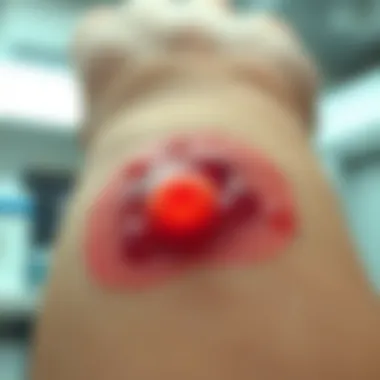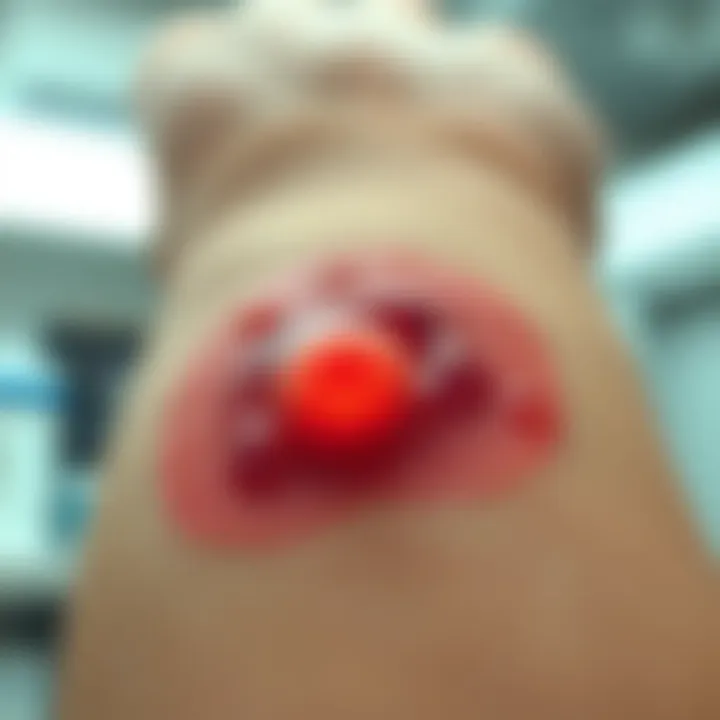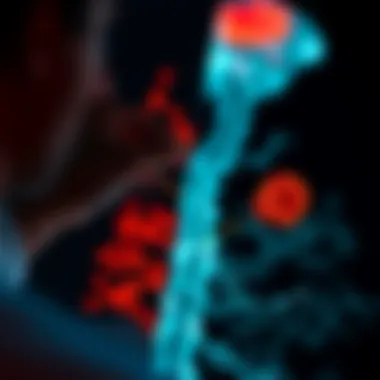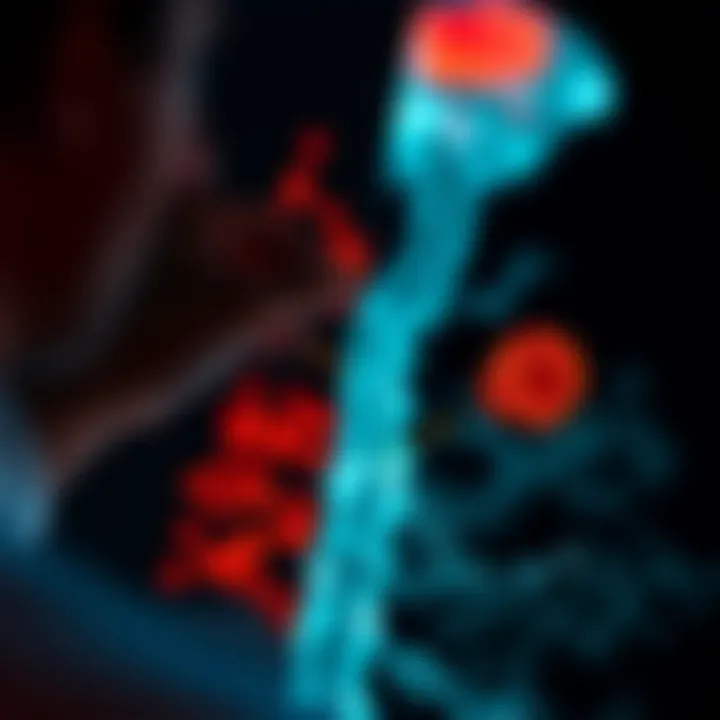Early Stage Leukemia Cutis: Insights and Images


Intro
Leukemia cutis – a term that may sound unfamiliar to many – represents a unique and rare manifestation of cutaneous involvement in leukemia. Early-stage leukemia cutis may slip under the radar, often mistaken for other dermatological conditions. Therefore, diving into this topic is essential for medical professionals, students, and educators alike, to sharpen their diagnostic acumen and refine their clinical approach.
This article will explore the characteristics and clinical implications of early-stage leukemia cutis. We'll illuminate both visual and clinical nuances, providing informative images that depict the condition’s early signs. An in-depth understanding not only aids in correct diagnosis but also highlights the significance of timely intervention, as delays can lead to more severe complications.
Emphasizing photographic documentation will also serve to enrich our comprehension, allowing for visual recognition that is often pivotal in dermatological assessments. Let’s begin our exploration by understanding the research landscape surrounding this elusive skin condition.
Foreword to Leukemia Cutis
In the realm of dermatology and hematology, leukemia cutis stands as a condition of unique interest due to its intricate skin manifestations often seen in patients battling leukemia. Understanding this phenomenon is crucial not only for clinical awareness but also for early detection and treatment planning. This article strives to unpack the layers surrounding leukemia cutis, particularly its early-stage presentation, providing valuable nuggets of information for students, educators, and medical professionals alike.
Definition and Overview
Leukemia cutis is characterized by the presence of leukemic infiltrates in the skin, which can present as varied lesions, including papules, nodules, or plaques. These skin changes arise as the leukemic process extends beyond the bloodstream, showcasing the disease's systemic nature. The skin may act as a remarkable mirror, reflecting the underlying hematological disorder. Both acute and chronic forms of leukemia can lead to this cutaneous manifestation, with symptoms often varying in appearance and severity, emphasizing the need for a nuanced understanding.
Historical Context
The recognition of leukemia cutis as a distinct clinical entity has taken time to unfold. Initially, its presentations were frequently misidentified or overlooked. Over the years, medical literature has chronicled cases that illustrate its impact, and advancements in imaging techniques and histopathological methods have refined its diagnostic criteria. Early records hinted at its existence in the 19th century, with significant evolutions in treatment and understanding following suit as leukemia itself became better understood. Indeed, the evolution of thought in this area has been shaped by ongoing research, revealing how intertwined the skin is with underlying disease processes.
Importance of Early Diagnosis
Recognizing leukemia cutis early can markedly influence patient management. Many practitioners may not immediately connect skin findings with hematological malignancies, leading to potential delays in diagnosis and treatment. An early, accurate identification of the cutaneous manifestations can lead to timely interventions, improving outcomes. In the medical community, awareness of these links is imperative. The visibility of the skin provides a unique opportunity to spot potential disease exacerbations. Therefore, education surrounding the clinical signs of early-stage leukemia cutis is essential for both new trainees and seasoned practitioners. Understanding this disorder not only enhances diagnostic accuracy but also encourages a proactive approach to patient care, showcasing the critical intersection between dermatology and hematology.
Pathophysiology of Leukemia Cutis
Understanding the pathophysiology of leukemia cutis is crucial in diagnosing and managing this complex skin manifestation related to underlying hematological malignancies. By comprehending the biological processes and alterations that lead to skin infiltration by leukemic cells, health professionals can better identify early-stage signs and improve patient outcomes. The pathophysiological exploration provides insight into the cellular and molecular foundations of leukemia cutis, emphasizing the interplay between genetic predispositions and external factors that may contribute to the disease’s progression.
Cellular Mechanisms
The development of leukemia cutis primarily involves the infiltration of leukemic cells into the dermal and epidermal layers of the skin. These cells can originate from both acute and chronic types of leukemia, leading to the appearance of various skin lesions. The fundamental cellular mechanism at play is the uncontrolled proliferation of these abnormal white blood cells, which disrupt the normal architecture of skin tissue.
In leukemia cutis, leukemic blast cells can migrate from the bloodstream and infiltrate skin tissue. One major pathway includes adhesion molecules like integrins, facilitating the adherence and infiltration. Once they gain access to the skin, they can provoke inflammatory responses that contribute to the characteristic lesions seen in patients.
Furthermore, local interactions between leukemic cells and the skin microenvironment can amplify these processes. Cytokines secreted by leukemic cells may enhance neovascularization, allowing for a greater blood supply and adding to the inflammatory milieu.
Genetic Factors
The genetic landscape of leukemia cutis plays a defining role in how the condition manifests. Specific chromosomal abnormalities, gene mutations, and molecular changes observed in leukemia can dictate not only the course of the systemic disease but also its cutaneous manifestations.
For instance, patients with certain mutations like FLT3 or NPM1 may experience a higher prevalence of skin involvement. Additionally, epigenetic modifications can alter gene expression patterns, further influencing the likelihood of skin lesions. This genetic predisposition underscores the need for a thorough genetic evaluation in patients presenting with leukemia cutis, as it may guide treatment decisions and provide insights into prognosis.
Associated Leukemias
Leukemia cutis is not a standalone entity but rather a manifestation associated with various forms of leukemia, notably acute myeloid leukemia (AML) and acute lymphoblastic leukemia (ALL). Each type presents with distinctive features and morphology of skin lesions, paralleling the underlying hematological disorder.
- Acute Myeloid Leukemia (AML): Patients often present with nodular lesions that may resemble other dermatoses, making diagnosis challenging. The lesions of AML can be violaceous and tender, drawing attention to their potential severity.
- Acute Lymphoblastic Leukemia (ALL): This variant may present with lighter-colored plaques or papules, sometimes resembling fungal infections. Characterizing these lesions is vital for correct identification and treatment planning.
Other leukemias, such as chronic myeloid leukemia (CML) and chronic lymphocytic leukemia (CLL), can rarely present with leukemia cutis, although the prevalence is lower. This highlights the necessity of being vigilant in examining skin lesions for signs of cutaneous leukemia across different types of hematological malignancies.
In summary, the pathophysiology of leukemia cutis is a complex interplay of cellular, genetic, and clinical factors. A deep understanding of these elements lays the groundwork for improving diagnostic accuracy and treatment strategies, reinforcing the importance of early intervention in affected patients.
Clinical Manifestations
Understanding the clinical manifestations of early-stage leukemia cutis is paramount for recognizing its presence and facilitating timely intervention. This skin condition can offer clues that are critical for an accurate diagnosis. Observing skin lesions uniquely associated with leukemia cutis enables healthcare providers to differentiate it from other dermatological conditions. This section highlights the importance of recognizing distinct clinical features, understands their implications, and underscores the necessity of precise differential diagnosis.
Common Skin Lesions


In the context of leukemia cutis, the skin lesions presented often take on various forms, yet they exhibit common characteristics that point toward the underlying hematological disorder. Typically, early-stage lesions may appear as
- Papules: Small, raised bumps which can come in various colors, including red or violaceous.
- Plaques: These are larger, flat areas that are often scaly and may resemble dermatitis.
- Nodules: Raised, solid lesions that could be mistaken for other skin issues if not examined closely.
Recognizing these skin lesions is the first step in identifying leukemia cutis. Although these lesions can sometimes mimic those seen in other dermatological conditions, their relationship with systemic leukemia is what sets them apart.
Distinctive Features of Early Stage
One of the most vital aspects of diagnosing early-stage leukemia cutis lies in distinguishing its unique features from other skin disorders. In the initial stages, these lesions often present in a subtle manner that may escape immediate attention. Some distinctive features include:
- Color Change: Lesions may display unusual colors compared to common dermatological issues, leaning towards darker hues or shades of purple.
- Location: While skin lesions can appear anywhere, leukemia cutis often emerges on the trunk and extremities, areas of the body that are easily overlooked during routine examinations
- Rapid Progression: Lesions may evolve quickly, with a noticeable increase in size and number over a short time—indicating the urgency of assessment.
Effectively identifying these distinctive features underscores the importance of vigilant observation in clinical settings, providing an avenue for immediate diagnosis and treatment.
Differential Diagnosis
Differential diagnosis for leukemia cutis can be a complex endeavor, given the wide array of skin conditions that exhibit similar manifestations. Clinicians must adopt a systematic approach to rule out other possibilities. Some common contenders include:
- Psoriasis: Often manifests with raised, silvery scales, but lacks the systemic implications associated with leukemia.
- Eczema: While eczema might share some overlapping features, it typically presents with itching and inflammation not seen with leukemia cutis lesions.
- Dermatological Infections: Bacterial or viral infections can mimic lesions but generally are accompanied by other signs of systemic infection.
To accurately diagnose leukemia cutis, healthcare professionals must consider both the clinical presentation and history of the patient, including any underlying hematologic conditions. Comprehensive skin assessments and, when necessary, biopsy can provide definitive conclusions, allowing for tailored care to commence promptly.
The critical nature of timely diagnosis cannot be overstated; misidentifying leukemia cutis could delay treatment for an underlying malignancy.
In summary, understanding the clinical manifestations of leukemia cutis, influenced by common lesions, distinctive features, and differential diagnosis, plays a significant role in patient outcomes. Such knowledge arms healthcare providers with the insight necessary to facilitate a correct diagnosis, ultimately guiding appropriate management strategies.
Importance of Photographic Documentation
Photographic documentation plays a vital role in understanding and managing early-stage leukemia cutis. This skin condition presents unique challenges; capturing its manifestations through photography elevates diagnostic accuracy and enhances educational value. As the saying goes, "A picture is worth a thousand words," which rings particularly true in the medical field where visual representation can clarify complex ideas and symptoms.
One key element of photographic documentation is its ability to create a reliable visual record of patients' lesions over time. When these images are carefully taken at various stages of the disease, they provide a timeline that can assist both in diagnosis and in monitoring treatment responses. Physicians can note changes in size, coloration, and morphology of skin lesions, yielding insights that may otherwise be missed during sporadic clinical assessments.
Additionally, the use of high-quality photographs in medical documentation fosters better communication among healthcare professionals. These images can serve as a reference point in case discussions, education sessions, or multidisciplinary meetings. For instance, a primary care physician may share photographs with a dermatologist to ensure a shared understanding of a patient's condition. This collaboration could lead to more accurate diagnoses and therapeutic strategies.
Furthermore, integrating photographic documentation into patient records supports evidence-based practices. By compiling a comprehensive library of skin manifestations associated with leukemia cutis, researchers and clinicians can study various patterns, establishing more robust diagnostic criteria, and consequently refining treatment protocols.
Role in Diagnosis
The role of photographic documentation in diagnosis cannot be understated. Accurate identification of early-stage leukemia cutis hinges on recognizing the subtle nuances of its clinical presentations. With carefully taken photographs, dermatologists and oncologists gain a powerful tool to assess and diagnose lesions accurately.
- Visual Analysis: Photographs enable a detailed visual analysis. Observations can include the texture, morphology, and coloration of skin lesions that may be critical for differential diagnosis.
- Precision: Repeated consultations of photographic data allows for precision in articulating the condition to other specialists, such as those in pathology or hematology.
- Comparison: Images taken at different times enable a side-by-side comparison that highlights any significant changes, facilitating timely adjustments to treatment.
"In medicine, visual details can be the difference between a correct diagnosis and a missed opportunity for effective treatment."
Educational Significance
The educational significance of photographic documentation extends beyond clinical practice. For students, residents, and healthcare professionals, exposure to real-life clinical visuals can bridge the gap between theoretical knowledge and practical application.
- Enhanced Learning: Visual aids enhance the learning experience. Medical education incorporates various media, but photographs of actual cases contribute to a more robust understanding of the condition's presentation and evolution.
- Peer Discussions: Shared images among peers can stimulate discussion, questioning, and analysis, fostering an environment of collaborative learning.
- Research Contributions: High-quality photographs are useful resources for academic research, enriching databases devoted to dermatologic conditions and malignancies.
By adhering to principles of clear lighting, proper focus, and consistent framing, medical practitioners can ensure that their photographic documentation remains an integral part of effective diagnosis and education related to early-stage leukemia cutis.
In sum, photographic documentation fortifies both the clinical and educational frameworks surrounding leukemia cutis, allowing for a more comprehensive understanding of this condition, thus paving the way for enhanced patient outcomes. It is a resource that should not merely complement existing diagnostic tools, but rather stand as a primary mechanism for observation and intervention.
Pictures of Early Stage Leukemia Cutis
In the realm of hemato-oncology, skin manifestations often become the first telltale signs of systemic disease. Understanding early stage leukemia cutis through the lens of photography provides crucial insights for diagnosis and clinical management. Photographic documentation illuminates the characteristics of various skin lesions and helps bridge the gap between theoretical knowledge and clinical practice. This visual representation enhances awareness among healthcare providers, allowing for quicker identification and a more targeted approach to treatment.


Clinical Case Studies
Clinical case studies serve as invaluable resources in understanding early stage leukemia cutis. They present real-world examples of how this condition can manifest in different individuals, highlighting the diversity of presentations based on genetic backgrounds, environmental factors, and comorbidities. By analyzing various documented cases, professionals nod to a few critical aspects:
- Variability in Presentation: Each case often illustrates how leukemia cutis can present uniquely; some may display papular lesions, while others may exhibit infiltrative plaques.
- Progression and Monitoring: Tracking the evolution of skin lesions in longitudinal studies can inform intervention strategies. For instance, a patient initially presenting with subtle erythematous patches may develop more prominent nodules, necessitating reassessment.
- Response to Treatment: Observing the responses to different treatments across diverse case studies can pinpoint effective strategies and potential challenges, informing future therapeutic directions.
These clinical vignettes serve not only as teaching tools but also as mirrors reflecting the real-life implications of early stage leukemia cutis.
Visual Patterns and Characteristics
The visual patterns associated with leukemia cutis are not merely aesthetic phenomena; they carry significant clinical implications. Understanding these characteristics aids in distinguishing leukemia cutis from other dermatoses.
- Common Patterns: The most prevalent visual patterns seen in early stages include:
- Descriptive Features: Notably, the lesions may be:
- Erythematous patches that may become more infiltrated and nodular.
- Purpura or petechiae, indicating potential infiltration of neoplastic cells in vascular structures.
- Ulcerations that develop with disease progression can herald systemic involvement.
- Asymptomatic or mildly itchy, which may lead patients to delay medical consultation.
- Scaly or crusted, with the potential for secondary infection if not properly managed.
A keen eye for these patterns, bolstered by photographic documentation, allows clinicians to recognize the telltale signs of leukemia cutis at an earlier stage. This early recognition can vastly improve patient outcomes and enhance the chances for effective intervention. Ultimately, integrating visual observations into clinical practice can foster a more dynamic understanding of this complex condition.
Diagnosis and Assessment
Diagnosis and assessment of leukemia cutis play a pivotal role in determining the prognosis and tailoring treatment approaches for patients. This section zeroes in on the nuances of clinical evaluation and biopsy usage, both essential for pinpointing the condition accurately in its early stages. By capturing the details of skin manifestations and understanding the significance of timely diagnostics, we can navigate the complexities of this rare disease more effectively.
Clinical Examination Protocol
The clinical examination protocol demands a thorough and systematic approach, particularly for conditions as nuanced as leukemia cutis. Healthcare professionals must be vigilant not only in observing the prevalent skin changes but also in recognizing atypical presentations, which may easily be misjudged or overlooked. A detailed protocol often follows these steps:
- Patient History: Begin by collecting comprehensive information regarding the patient’s medical background, including any history of hematologic disorders, current medications, and systemic symptoms such as fever, weight loss, or fatigue.
- Physical Examination: Carefully inspect the skin, focusing on lesions that present atypically. Early-stage leukemia cutis can manifest as nodular lesions or diffuse infiltrates that may be mistaken for other dermatological conditions.
- Documentation: High-quality photographic documentation is critical. Images help track the progression or regression of lesions over time, providing a visual reference that enhances diagnostic accuracy during follow-up consultations.
- Differential Diagnosis: Clinicians must think broadly. Conditions such as cutaneous lymphoma or infections might mimic leukemia cutis. It’s vital to assess these possibilities thoroughly to avoid misdiagnosis.
- Referral to Specialists: If clarity remains elusive after a careful examination, referral to a dermatologist or a hematologist might be necessary for further exploration.
An effective clinical exam not only highlights potential leukemia cutis but can also reveal systemic signs that could indicate a more extensive hematologic process.
Use of Biopsy in Diagnosis
A biopsy serves as one of the most definitive methods for assessing suspected leukemia cutis. The process involves obtaining a small sample of the lesion for microscopic examination and is crucial for several reasons:
- Histological Evaluation: The biopsy reveals the cellular composition and architecture of the lesions. Pathologists can identify the presence of leukemic cells in the skin, which is a definitive indicator of leukemia cutis.
- Identification of Associated Conditions: Sometimes, biopsies can also reveal other underlying conditions that may coincide with leukemia cutis, such as infections or autoimmune disorders. This multifaceted approach broadens the understanding of the patient's overall health status.
- Guidance for Treatment: Understanding the nature of the lesions through biopsy results assists healthcare professionals in formulating an effective treatment plan tailored to the individual patient’s needs. Furthermore, this can help assess the aggressiveness of the leukemia and the potential outcome.
- Monitoring Disease Progression: A repeat biopsy may be warranted to evaluate treatment response or disease progression. Biopsies serve as a benchmark, giving tangible data that can inform subsequent clinical management decisions.
In sum, both clinical examination and biopsy play crucial roles in the diagnostic puzzle of early-stage leukemia cutis. Together, they facilitate early detection, ensuring timely and accurate treatment, thus improving overall patient outcomes.
Treatment Options
In tackling the complexities of early-stage leukemia cutis, understanding the treatment options available is essential. The approach to managing this condition is multifaceted, taking into account the individual patient's health status, the extent of the disease, and the underlying leukemia type. Treatment isn't a one-size-fits-all affair; rather, it's akin to tailoring a finely crafted suit: it requires careful consideration and adjustments.
Current Treatment Modalities
Current treatment modalities for leukemia cutis primarily revolve around addressing the skin manifestations while also managing the underlying hematological condition. Some key points include:
- Chemotherapy: Standard chemotherapy regimens used for leukemia often reduce skin lesions as a secondary effect. Agents like doxorubicin or cytarabine have shown effectiveness in regressing these skin lesions, but their efficacy can vary from one individual to another. The treatment's main focus remains on the leukemia itself, with skin improvement being a hopeful byproduct.
- Topical Treatments: For localized skin lesions, dermatologists may prescribe topical agents like corticosteroids. These can help reduce inflammation and manage discomfort, though they do not affect the underlying leukemia.
- Phototherapy: This method involves the use of light to treat skin lesions. Narrowband UVB or PUVA therapies may be effective in certain cases. However, while this modality might soothe the skin, it does so without altering the progression of the underlying leukemia.
- Supportive Care: In cases where lesions cause pain or distress, supportive options such as pain management and palliative measures become vital. Collaboration with palliative care specialists ensures that the patient's quality of life remains a priority.
It's crucial to engage in shared decision-making with patients regarding these treatments, as they may have personal preferences shaped by their previous experiences or values. Treatment strategies should be monitored closely, adjusting as necessary based on the patient’s response and any side effects encountered.
Experimental Therapies
As we tread into the realm of experimental therapies, we uncover possibilities that could reshape the approach to treating leukemia cutis. While current treatments form the backbone of care, ongoing research is vital for innovation. Some emerging strategies include:
- Targeted Therapy: Targeted treatments that focus on specific genetic mutations associated with leukemia hold promise. Agents such as tyrosine kinase inhibitors, like imatinib, potentially could help not just with blood manifestations but also with skin lesions.
- Immunotherapy: Leveraging the body's immune system is increasingly being explored. Techniques like CAR T-cell therapy aim to enhance the body’s natural defenses against cancer cells, which may positively impact both systemic and cutaneous involvement of leukemia.
- Novel Biologics: Medications that are still in the trial stages may offer hope. These biologics target pathways that are pivotal for cancer growth, possibly paving the way for future standard treatments for not just leukemia, but its cutaneous manifestations too.


As noted, "Each patient's case is unique, and ongoing research efforts are essential to improve understanding and management of leukemia cutis."
For more detailed information, refer to sources such as American Society of Hematology and National Cancer Institute.
Prognosis and Follow-Up
The prognosis and follow-up care for patients with early-stage leukemia cutis is a topic of great significance not just for medical professionals, but also for patients and their families. Understanding the long-term outcomes of this condition provides vital insights into treatment effectiveness and the overall management of the disease. Early intervention is crucial, as it can heavily influence both patient quality of life and survival rates.
Outcome Measures
When assessing the prognosis for individuals with leukemia cutis, a variety of outcome measures are employed to determine the effectiveness of treatments and the progression of the disease. These measures include:
- Clinical Recovery Rates: This provides a direct indication of how many patients respond successfully to initial therapies. High recovery rates can signal effective treatment strategies.
- Skin Lesion Resolution: Monitoring the clearance of skin lesions over time can demonstrate how well a patient is responding to treatment. Improvement in the appearance and feel of affected areas often correlates with positive clinical outcomes.
- Patient-Reported Outcomes: Gathering subjective data from patients about their experiences, including pain levels and their emotional wellbeing, can offer additional dimension to evaluating success beyond clinical metrics.
- Progression-Free Survival (PFS): A critical measure that indicates how long patients live without signs of disease progression, contributing significantly to understanding the long-term effectiveness of treatment options.
Evaluating these outcome measures not only influences clinical decisions but also shapes ongoing research into more effective management strategies.
Long-Term Monitoring Strategies
As part of the comprehensive care approach, long-term monitoring strategies play an essential role in managing leukemia cutis. Regular follow-up is crucial to catch potential relapses and to address any emerging complications promptly. Some strategies include:
- Regular Dermatological Assessments: The skin often serves as a window into a patient's systemic health. Periodic skin checks can help identify any new lesions or changes in existing ones, ensuring timely interventions.
- Blood Work and Imaging: Beyond skin evaluations, blood tests such as complete blood counts (CBC) and imaging studies can help monitor the overall health of patients and detect systemic involvement of leukemia.
- Multidisciplinary Approach: Collaborating with various specialists, including hematologists and pathologists, ensures a well-rounded care plan tailored to the patient's specific needs. This helps mitigate complications often associated with traditional treatment methods.
- Patient Education: Informing patients about what signs to look for, potential side effects of treatment, and the importance of adhering to follow-up appointments encourages active participation in their healthcare.
Maintaining vigilance in prognosis and follow-up not only enables healthcare professionals to provide better care but also empowers patients by actively engaging them in their health journey.
Future Directions in Research
Research into leukemia cutis is essential, particularly when focusing on early-stage identification and treatment. Understanding this rare skin manifestation associated with leukemia can vastly improve patient outcomes. Research advancements reveal that clarity in diagnostic techniques and effective treatment options could pivotally alter the trajectory of this condition.
Emerging Diagnostic Techniques
One of the most promising developments in diagnosing early-stage leukemia cutis is the integration of cutting-edge imaging technologies. Dermoscopy, for instance, magnifies skin lesions, allowing for a more precise examination of morphological features that could indicate underlying leukemic involvement.
The shift towards non-invasive diagnostic tools heralds a new era in early detection of leukemia cutis.
Moreover, genetic profiling has begun to shine in this arena. Techniques like Next-Generation Sequencing (NGS) allow researchers to delve into individual genetic variations that could predispose patients to leukemia cutis. By identifying specific markers, healthcare professionals may not only enhance diagnostic accuracy but also personalize treatment pathways tailored to the patient’s unique genetic makeup.
In conjunction with imaging and genetic approaches, advancements in artificial intelligence hold promise as well. Algorithms trained on vast datasets can assist in assessing skin lesions, minimizing human error and increasing diagnostic consistency. The key to leveraging AI lies in its continuous learning capabilities, which adapt to new data and evolving clinical best practices.
Potential for Innovative Treatments
Parallel to diagnostics, the future of treating leukemia cutis is also seeing innovations. Immunotherapy, in particular, is gaining traction as researchers explore its viability in managing cutaneous manifestations. By harnessing the body’s immune system to target malignant cells more effectively, treatments could become less toxic compared to traditional options like chemotherapy.
Targeted therapies further represent a new frontier. Drugs that specifically inhibit signaling pathways involved in leukemic progression can be instrumental in managing both leukemia and leukemia cutis. For example, agents that block the FLT3 receptor have shown promise in treating acute myeloid leukemia, and there's potential for their application to associated skin manifestations.
Additionally, exploring the role of topical agents might offer alternative routes of treatment. Clinicians are investigating compounds that could be directly applied to skin lesions, thus localizing treatment and reducing systemic side effects. This pragmatic approach aligns with the growing trend of targeted localized therapies.
As research progresses, collaborative efforts between dermatologists and hematologists will be vital. Multi-disciplinary teams can foster a holistic understanding of patient needs and treatment pathways, thereby improving survival rates and quality of life.
The End
The exploration of early-stage leukemia cutis reveals significant insights into a condition that, while rare, presents unique challenges in both diagnosis and management. This article underscores the critical importance of early recognition and intervention, highlighting the nuanced clinical manifestations that can serve as harbingers of underlying hematologic malignancies.
Summary of Key Points
- Definition and Clinical Manifestations: Early-stage leukemia cutis is characterized by specific skin lesions that often resemble other dermatologic conditions. Recognizing these features is vital for timely diagnosis.
- Diagnostic Techniques: The role of photographic documentation not only aids in diagnosis but serves as a valuable educational tool, enhancing understanding among healthcare providers and students alike.
- Implications for Treatment: Knowledge about treatment modalities, including both established and experimental therapies, is important for managing this condition effectively. Proactive engagement with novel therapeutic approaches may enhance patient outcomes.
- Future Research Directions: Emerging diagnostic techniques and innovative treatment strategies hold promise for reshaping the landscape of how early-stage leukemia cutis is approached in clinical settings.
Implications for Future Studies
The future of research in leukemia cutis is ripe with potential. There is a pressing need for larger-scale studies that further elucidate the genetic and cellular mechanisms underpinning this condition. Research focusing on:
- Multi-Omics Approaches: Integrating genomic, transcriptomic, and proteomic data may reveal hidden biomarkers for early detection.
- Intervention Studies: A closer look at the long-term outcomes of patients treated for leukemia cutis can offer insights into optimal management strategies.
- Public Awareness Campaigns: Increasing awareness about the presentations and implications of early-stage leukemia cutis among healthcare professionals and the general public could improve early diagnosis rates.
Thus, as we continue to further our understanding of this complex condition, both the medical community and researchers have crucial roles in improving the quality of care for affected individuals. A commitment to ongoing education, innovative research, and a focus on the nuances of early-stage presentations will undoubtedly enhance the clinical landscape for leukemia cutis.















